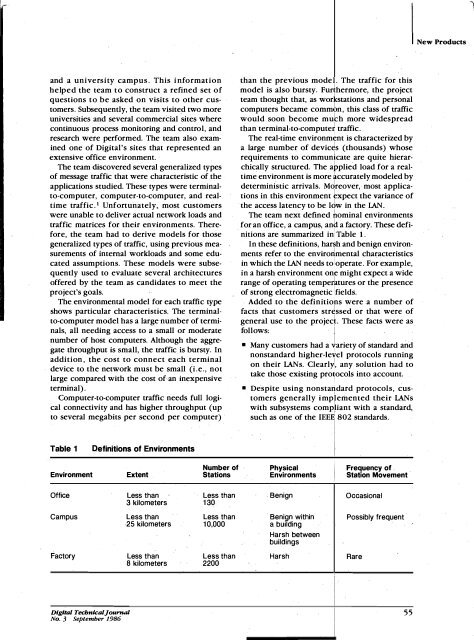DTJ Number 3 September 1987 - Digital Technical Journals
DTJ Number 3 September 1987 - Digital Technical Journals
DTJ Number 3 September 1987 - Digital Technical Journals
Create successful ePaper yourself
Turn your PDF publications into a flip-book with our unique Google optimized e-Paper software.
lNew Productsand a university campus. This informationbel ped the team to construct a refined set ofquestions to be asked on visits to other customers.Subsequently, the team visited two moreuniversities and several commerCial sites wherecontinuous process monitoring and control, andresearch were performed. The team also examinedone of <strong>Digital</strong>'s sites that represented anextensive office environment.The team discovered several generalized typesof message traffic that were characteristic of theapplications studied. These types were terminalto-computer,computer-to-computer, and realtimetraffic.1 Unfortunately, most customerswere unable to deliver actual network loads andtraffic matrices for their environments. Therefore,the team had to derive models for thosegeneralized types of traffic, using previous measurementsof internal workloads and some educatedassumptions. These models were subsequentlyused to evaluate several architecturesoffered by the team as candidates to meet theproject's goals.The environmental model for each traffic typeshows particular characteristics. The terminalto-computermodel has a large number of terminals,all needing access to a small or moderatenumber of host computers. Although the aggregatethroughput is small, the traffic is bursty. Inaddition , the cost to connect each terminaldevice to the network must be small (i.e., notlarge compared with the cost of an inexpensiveterminal).Computer-to-computer traffic needs full logicalconnectivity and has higher throughput (upto several megabits per second per computer)Table 1EnvironmentOfficeDefinitions of EnvironmentsExtentLess than3 kilometers<strong>Number</strong> ofStationsLess than130than the previous model. The traffic for thismodel is also bursty. Furthermore, the projectIteam thought that, as workstations and personalcomputers became commbn, this class of trafficwould soon become muth more widespreadthan terminal-to-compute traffic.The real-time environment is characterized bya large number of devict!s (thousands) whose. Irequirements to communicate are quite hierarchicallystructured. The applied load for a realtimeenvironment is more accurately modeled bydeterministic arrivals. Mdreover, most applicationsin this environment xpect the variance ofthe access latency to be lrlw in the IAN .The team next defined hominal environmentsfor an office, a campus, ana a factory. These definitionsare summarized inl Table 1.In these definitions, harsh and benign environmentsrefer to the envirorlmental characteristicsin which the IAN needs to I operate. For example,in a harsh environment one might expect a widerange of operating temperluures or the presenceof strong electromagnetic lfields.Added to the definitions were . a number ofIfacts that customers stressed or that were ofgeneral use to the projec. These facts were asfollows:I . .. .• Many customers had a variety of standard andnonstandard higher-led protocols runningon their LANs. Clearl, any solution had totake those existing protocols into account.• Despite using nonstaJdard protocols, cus-1tomers generally implemented their LANsIwith subsystems compiant with a standard,such as one of the IEEE 802 'tandards.PhysicalEnvironmentsBenignIIIFrequency ofStation MovementI OccasionalCampusLess than25 kilometersLess than10,000· Benign withina buildingPossibly frequentHarsh betweenbuildingsFactoryLess than8 kilometersLess than2200HarshRare<strong>Digital</strong> TecbnlcalJournalNo. 3 <strong>September</strong> 198655









